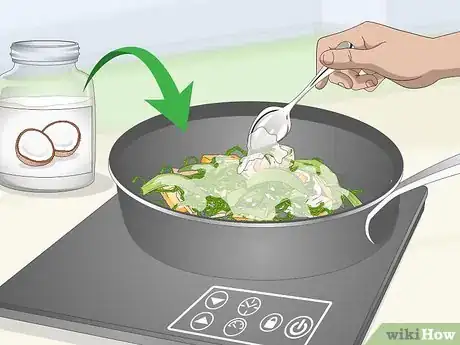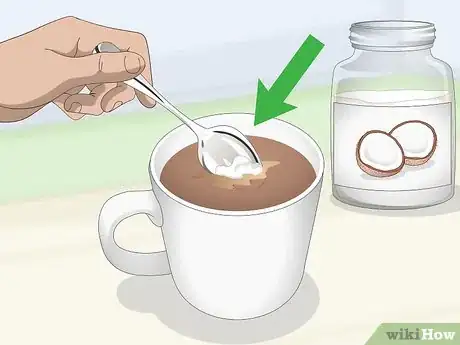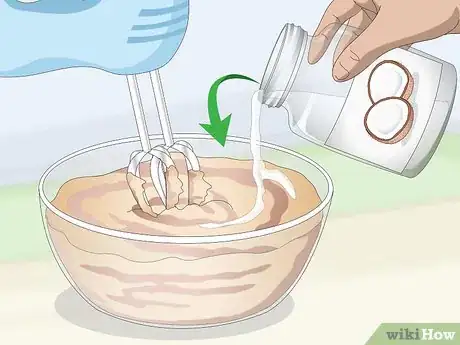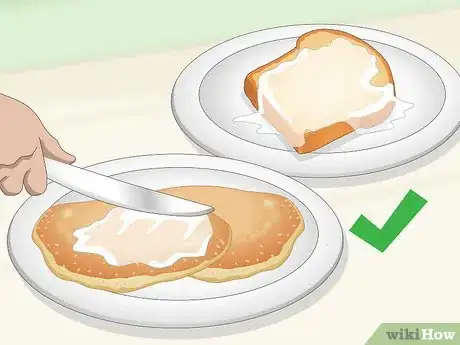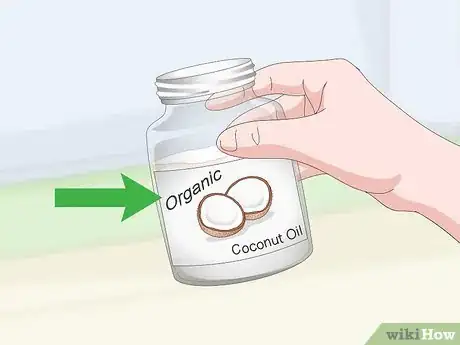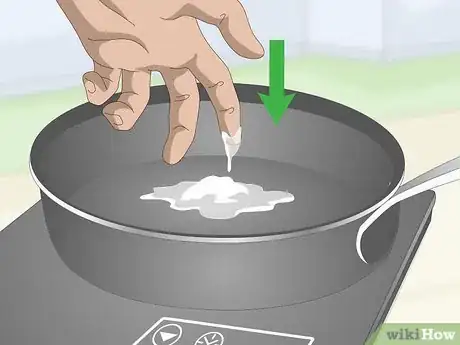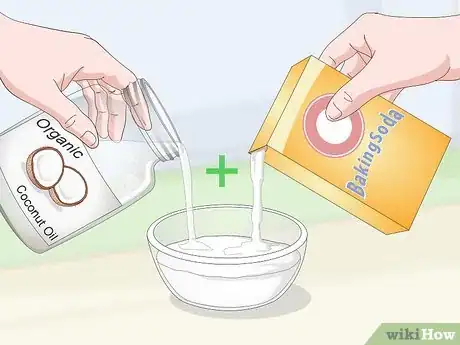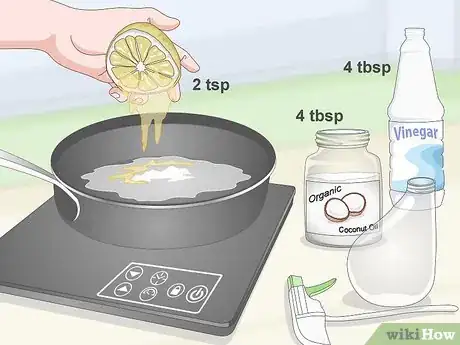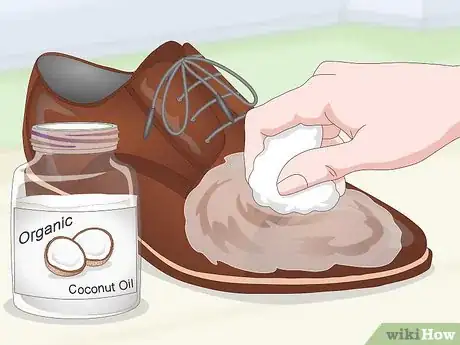This article was co-authored by Barbie Ritzman and by wikiHow staff writer, Christopher M. Osborne, PhD. Barbie Ritzman is a Beauty Specialist, Influencer, and the Owner of Barbie’s Beauty Bits. With over 10 years of experience in the beauty industry, she specializes in skincare and aesthetics. Barbie studied marketing at Tidewater Community College and holds a Certificate from the Media Buying Academy. For her work, she’s won Beauty Influencer of the Year - The USA and was featured in “The Allure 50,” which includes the year’s 50 most influential people in the beauty industry.
There are 11 references cited in this article, which can be found at the bottom of the page.
wikiHow marks an article as reader-approved once it receives enough positive feedback. In this case, several readers have written to tell us that this article was helpful to them, earning it our reader-approved status.
This article has been viewed 142,960 times.
Coconut oil has developed a reputation as a superfood and all-around wonder product. You can cook with it, use it as a face moisturizer or hair conditioner, or even clean with it, among other uses. So, even though most of its claimed health benefits have little scientific research to back them up, coconut oil may be worth giving a try![1]
Steps
Eating Coconut Oil
-
1Use coconut oil for sautéing, pan frying, or roasting. Since it has a high smoke point and mild flavor, coconut oil is a great choice for a variety of cooking methods. If you’re sautéing or pan frying, use an equal amount of coconut oil as whatever other fat the recipe calls for (butter, olive oil, vegetable oil, etc.).[2]
- To roast vegetables with coconut oil, melt 1-2 tablespoons (15-30 ml) of the oil—or whatever amount your recipe calls for—over low heat in a small saucepan, then drizzle it over your veggies on the roasting pan. Season and roast the vegetables according to your chosen recipe.
-
2Stir coconut oil into coffee, hot tea, or hot chocolate. Simply make your hot beverage of choice as usual, then stir in 1 tsp (5 ml) of coconut oil before adding any cream or sweetener. The hot liquid will quickly melt the congealed oil.[3]
- The coconut oil will create a bit of an oily texture (especially on the surface) and impart a mild flavor to the beverage. If you don’t care for the results, try replacing half of the coconut oil with unsalted butter (or just cut back on the coconut oil and don’t substitute anything else).
- Is it worth making your morning coffee a bit oily by adding coconut oil? It might be. It's possible, but not certain, that coconut oil may help reduce cholesterol, burn fat, kill harmful bacteria, and improve brain function, among other benefits.[4]
Advertisement -
3Blend coconut oil into your favorite smoothie recipe. Just spoon in 1-2 tbsp (15-30 ml) of coconut oil with the other ingredients and blend them together. Congealed coconut oil may leave small chunks in your smoothie—if this bothers you, melt the coconut oil on the stovetop using low heat, then drizzle it into the smoothie ingredients before blending.[5]
- Coconut oil tastes great with smoothies that use bananas and other tropical fruits.
-
4Substitute coconut oil for other oils when baking. If your baking recipe calls for another liquid oil, like canola or vegetable oil, use an equal amount of melted coconut oil. You probably won’t notice any difference in flavor or texture.
- If you want to substitute coconut oil for a solid fat like shortening, butter, or margarine, use a 1:1 ratio of congealed coconut oil and the other solid fat, but add only 75% of the amount called for in the recipe. For instance, instead of 4 tbsp (60 ml) of butter, add 3 tbsp (45 ml) total of coconut oil and butter—1.5 tbsp (~23 ml) of each.
-
5Spread coconut oil on toast or pancakes instead of butter. Coconut oil will soften to a spreadable consistency as it approaches 76 °F (24 °C), at which point you can easily spread it onto a muffin or corn-on-the-cob. It provides a nice change of pace to the taste of butter![6]
- Or, try melting 1-2 tbsp (15-30 ml) of coconut oil and drizzling it over your popcorn!
Moisturizing Your Face
-
1Buy coconut oil that is organic, extra virgin, and unprocessed. Use a coconut oil that is as natural and unadulterated as possible. Avoid jars with terms like “bleached,” “hydrogenated,” “refined,” or “deodorized.” The term “cold-pressed” is a good thing to see on the label, though, as this is a natural process for extracting the oil.[7]
- Look for this coconut oil at stores that sell natural food and health products. It typically comes in a glass jar and looks like a whitish gel or paste.
- Coconut oil is a super ingredient that offers many benefits for the skin. It is very hydrating and has anti-inflammatory and anti-bacterial properties.
-
2Massage in 1 teaspoon (5 ml) of coconut oil after washing your face. Wash your face with a gentle soap, rinse it with warm water, and pat it dry with a towel. Scoop about 1 tsp (5 ml) of the gelatinous coconut oil on your first two fingers, then massage it into your skin using circular motions. Repeat this process daily.[8]
- Your body warmth will melt the oil and it will absorb into your skin.
- Coconut oil works best if you have dry or normal skin. If you have oily skin, choose a different natural product, like argan oil or sunflower oil.[9]
EXPERT TIPJoanna Kula is a Licensed Esthetician, Owner and Founder of Skin Devotee Facial Studio in Philadelphia. With over 10 years of experience in skincare, Joanna specializes in transformative facial treatments to help clients achieve a lifetime of healthy, beautiful, and radiant skin. She is also a contributing author for the prestigious Les Nouvelles Esthetiques & Spa magazine and has been featured in a number of magazines including InStyle.Licensed Esthetician
 Joanna Kula
Joanna Kula
Licensed EstheticianUse coconut oil cleansers sparingly. Coconut oil can leave behind a layer of residue on your face, and it is also a comedogenic product, which means it clogs your pores and can cause acne.
-
3Use melted coconut oil in a moisturizing face mask. Melt 1 tbsp (15 ml) of coconut oil over low heat on the stove, then stir it together with half of a mashed banana and a pinch of turmeric. Use your fingers to apply the mask to your face, leave it for 15 minutes, rinse it away with cool water, and pat your face dry. Repeat daily if desired.[10]
- This mask may help both moisturize your skin and reduce acne breakouts. Bananas may help add moisture, while turmeric may offer anti-inflammatory properties.
- You can also mix coffee grounds and coconut oil to exfoliate dead skin cells and reveal healthy glowing skin.
Conditioning Your Hair
-
1Scoop about 1 tbsp (15 ml) of congealed coconut oil onto your fingers. If you have short hair, you may only need half of this amount. Buy organic, extra virgin, unprocessed coconut oil from a health food retailer for this application.[11]
- Store the coconut oil in its glass jar at a temperature below 76 °F (24 °C); this will keep it in its congealed form.
-
2Melt the coconut oil over low heat, or in your hands. Put the scoop of oil in a small saucepan and place it over low heat on the stove. Let it cool enough that you can comfortably handle the oil.[12]
- Alternatively, you can melt small amounts of the coconut oil in your hands while you massage it into your hair.
-
3Massage the oil into your hair, section by section. If you have long hair, divide it into sections with a comb and hair clips. Then, dip your fingers into the melted oil and use your fingertips to massage it in from the roots to the tips of the hair in each section.[13]
- If you’re using unmelted coconut oil, scoop up just enough to work into the section of hair you’re working on, rub it between your fingers for 15-30 seconds until it melts, and massage it in with your fingertips.
-
4Wait at least 30 minutes before shampooing out the coconut oil. If possible, wait at least 2 hours before washing out the coconut oil—this will give it more time to absorb into your hair. When you’re ready, just use your typical shampoo to wash your hair, then rinse and dry as normal.[14]
- You can even keep the coconut oil in overnight. Just make sure you put a towel down on your pillow so it doesn’t end up stained. You might also want to put on a shower cap overnight.
Cleaning with Coconut Oil
-
1Remove stains with coconut oil and baking soda. Thoroughly mix equal parts of coconut oil and baking soda—for instance, 1 US cup (240 ml) of each. Apply the mixture to stains on carpeting, walls, and other surfaces with a cloth, leave it for 5-10 minutes, then wipe it away with a damp cloth.[15]
- Like any stain remover, this may cause damage or discoloration to some surfaces. Test it on an inconspicuous area—like the corner of the carpet under the end table—before applying it to the stain.
-
2Make a coconut oil furniture polish. Melt 4 tbsp (60 g) of coconut oil in a small saucepan over low heat. Mix in 4 tbsp (60 ml) of white vinegar and 2 tsp (10 ml) of lemon juice, then add it to a spray bottle. Shake the bottle, spray a light coating of the mixture on your wood furniture, and buff it off with a clean, soft cloth.[16]
- Test the cleaner on a hidden area of the furniture first, just in case it reacts with the finish and causes staining or discoloration.
- Use the mixture right away, since the coconut oil will congeal if it cools below 76 °F (24 °C).
-
3Clean and condition leather with straight coconut oil. Scoop a fingertip-sized amount of coconut oil onto a clean cloth. Work it into the leather item using a circular rubbing motion, leaving behind only a thin, shiny film of oil. Add more coconut oil to a clean section of the cloth as needed.[17]
- Test the coconut oil on a small spot of the leather first. There’s a small chance it may discolor your favorite leather jacket or sofa!
-
4Lift away sticky residue by rubbing on coconut oil. Scoop a small amount of coconut oil onto a cloth and rub it into the sticky spot. The oil should cause the sticky residue to release and lift away. Wipe the area with a damp cloth if needed.[18]
- Try this on a sticky spot on your carpet, or to remove tacky residue left behind by a price tag or other sticker.
- Like always, test the coconut oil on an inconspicuous area first.
Community Q&A
-
QuestionCan coconut oil be used as lube (lubricant)?
 Community AnswerYes! Your best option would be to purchase the "top shelf" quality product: virgin unrefined coconut oil. Otherwise, you're purchasing something that has been boiled, bleached, and processed from alternative sources, not coconut.
Community AnswerYes! Your best option would be to purchase the "top shelf" quality product: virgin unrefined coconut oil. Otherwise, you're purchasing something that has been boiled, bleached, and processed from alternative sources, not coconut.
Things You’ll Need
- Organic, extra virgin, unrefined coconut oil
- Small saucepan for melting (optional)
References
- ↑ http://www.berkeleywellness.com/healthy-eating/diet-weight-loss/food/nutrition/article/coconut-oil-all-its-cracked-be
- ↑ https://wellnessmama.com/health/eat-more-coconut-oil/
- ↑ https://wellnessmama.com/5673/healthy-coffee/
- ↑ https://www.healthline.com/nutrition/top-10-evidence-based-health-benefits-of-coconut-oil
- ↑ https://wellnessmama.com/health/eat-more-coconut-oil/
- ↑ https://www.md-health.com/Substitute-Coconut-Oil-For-Butter.html
- ↑ https://blog.paleohacks.com/coconut-oil-for-skin/#
- ↑ https://www.prevention.com/beauty/a20428276/coconut-oil-cures-for-your-skin-and-hair/
- ↑ https://thethingswellmake.com/homemade-moisturizer-oily-acne-prone-skin/
- ↑ https://www.prevention.com/beauty/a20428276/coconut-oil-cures-for-your-skin-and-hair/
- ↑ https://www.naturallivingideas.com/coconut-oil-for-hair/
- ↑ https://www.naturallivingideas.com/coconut-oil-for-hair/
- ↑ https://www.naturallivingideas.com/coconut-oil-for-hair/
- ↑ https://www.naturallivingideas.com/coconut-oil-for-hair/
- ↑ https://www.tasteofhome.com/article/coconut-oil-uses-for-any-room-of-the-house/
- ↑ https://www.tasteofhome.com/article/coconut-oil-uses-for-any-room-of-the-house/
- ↑ https://www.tasteofhome.com/article/coconut-oil-uses-for-any-room-of-the-house/
- ↑ http://www.treehugger.com/green-home/how-remove-stains-clothes-and-carpet-naturally.html
- ↑ https://www.healthline.com/nutrition/top-10-evidence-based-health-benefits-of-coconut-oil
About This Article
Use coconut oil when you're sautéing, pan-frying, or roasting instead of your usual vegetable or canola oil. For a tasty treat, add a spoonful of coconut oil to a cup of tea or coffee, or drop a tablespoon into your favorite smoothie mixture before blending it. You can also use coconut oil in baked goods, like cookies or cakes, to create a richer flavor. Because of its excellent moisturizing properties, use the oil on your skin and hair for a dose of hydration. For tips on incorporating coconut oil into your beauty routine, read on!
